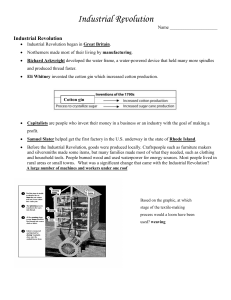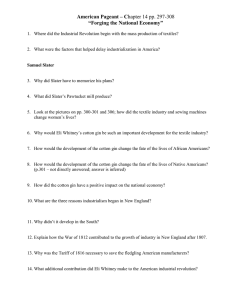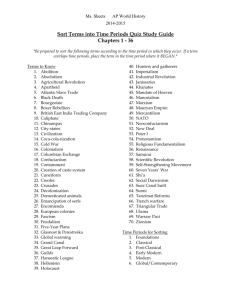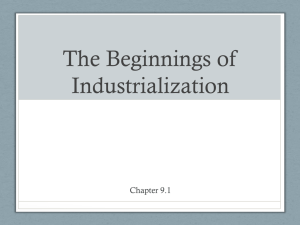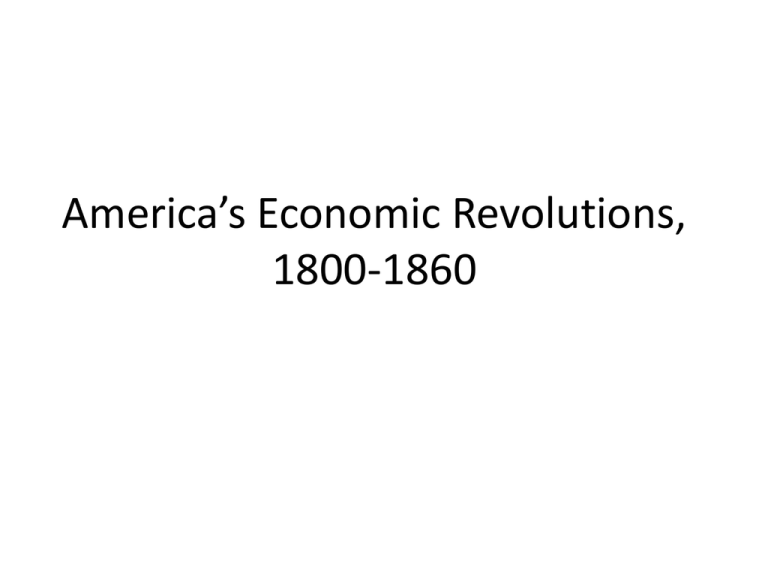
America’s Economic Revolutions,
1800-1860
Market Revolution
• Farming becomes more commercialized
– More growing crops for trade, not for subsistence
– More specialized – e.g., “I’m a wheat farmer.”
– Larger markets, more intermediaries, less personal
– More competition, more price fluctuation
– Generation gaps, long migrations
– New machine technologies – McCormick reaper
• Increasing cost of starting or running a farm
Market Revolution
• National and regional markets, not just local
• New social customs
– More clock-based schedules
– Fascination with numbers and calculations
Thomas Hicks, Calculating (1844)
Technological Revolution
• Cotton gin, patented 1793
(“Gin” short for “engine” = something with gears)
– Processed raw cotton 15X faster than by hand
– Made poor quality cotton plants profitable
– Stimulated cotton boom, expansion across South
– Made slave labor more profitable
• Irony: labor-saving device encouraged spread
of slavery
Textile Revolution – “King Cotton”
Cotton gin more cotton in more places
Long staple cotton -high quality bolls; very specific
soil requirements; less impact
on soil
Short staple cotton -Lower quality bolls; more
adaptable to different soils;
more impact on soil
7
Chapter Eight:
Varieties of American Nationalism
© 2011, The McGraw-Hill
Companies, Inc. All Rights
Reserved.
The Missouri Compromise, 1820
Technological Revolution
• Interchangeable parts (also Eli Whitney)
– Standardization mass production cheaper
products
– Basis for assembly line later
– Basis for modern-day material world
– Early application: firearms (Colt pistols)
– A key part of “the American system” of
production
Technological Revolution
• Steam power
–Enormous improvement over muscle power
–Synergy with coal, steel, lumber industries
–At first, stationary engines, for example in
mining
–Then, made mobile – railroads, steamships
Transportation Revolution
• Canal building
– Ancient technology with a new life
– Takes advantage of benefits of water transportation
– Example: Erie Canal, 1825
• Connected Hudson River with Lake Erie
• Dug with hand tools, gunpowder
• Made for horse-drawn barges
• On time, on budget, paid off earlier than expected
• Transformed economy of upstate New York, Great
Lakes, and Ohio valley
Canals in the Northeast, 1823-1860
Transportation Revolution
• Steamships
– Independent of wind, less susceptible to current
– Require fuel – changes maritime industry, strategy
– Made rivers into two-way streets
(Steamships exploded, but only about 1 in 20)
• Railroads
– Made traveling over land as easy as or easier than by
water
– Symbol of progress, triumph over nature
– Transform perceptions of time and space
– First large corporations
Rail Transport
• 1804: first steam-powered locomotive
– Capacity: Ten tons + 70 passengers @ 5 mph
• The Rocket from Liverpool to Manchester (UK)
(1830), 16 mph
• Sense of progress: “triumph over nature”
• Sense of space, time, speed
– Time zones
– Shortened travel times
– Unprecedented speeds – 35 mph!
14
Railroad
Growth,
1850-1860
© 2011, The McGraw-Hill
Companies, Inc. All Rights
Reserved.
15
Transportation Revolution
• Results – by 1860:
– Freight costs dropped 95%
– Travel speed increased 400%
In today’s terms:
Fly Seattle to NYC for $20, at 1500 miles per hr
Or, maybe teleportation?
– Much “smaller” country, despite expansion
– More integrated national market
– More integrated politics and culture
– One key factor in your 19th C. life:
proximity to railroad or river/canal
Communications Revolution
• Telegraph
– Instantaneous long-distance communication
• At the speed of electric current through a wire
– Infrastructure demands
• Steel (wires) and timber (poles)
• Underwater cables developed by 1900
By 1910, a fully global network:
The King of England sent himself a telegram around
the world.
– Transformed concept of space and time
• East Coast in conversation with West Coast
Communications Revolution
Telegraph
Instantaneous communication using short messages in
simple, coded textual language, created by tiny finger
movements
How primitive!
How far we’ve come since then!
IKR? LOL ;-)
Puck magazine, 1881
1903 version of a Twitter burn
(telegrams)
Elihu Root, in DC:
HOW IS YOUR HEALTH?
William Howard Taft, in Philippines:
GOOD. RODE 25 MILES TO TOP OF MOUNTAIN.
Root:
HOW IS HORSE?
#taftisheavy

